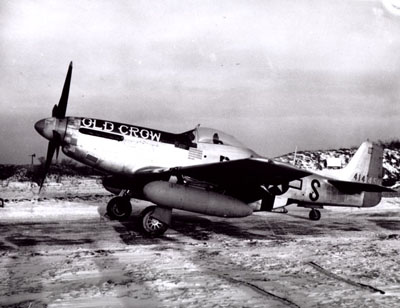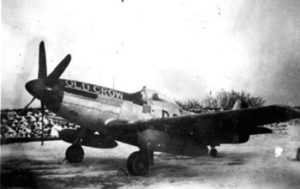357th FG Profile

Major Clarence E. “Bud” Anderson’s P-51D Mustang “Old Crow”

Important Update!! – This profile is in error for the WWII Old Crow. There were no black stripes on the wing and horizontal tail as shown here. These are on the restored P-51D “Old Crow” that is flying today. They were put on for looks!

These photos show the top of the wing with no black stripes!

Winter 1944
Modeler Tips:
Side View Notes:
A. Rear red band on propeller boss extends onto spinner to leading edge of blades when in neutral pitch. Determine width of yellow band by dividing remainder of spinner evenly.
B. “Old Crow” lays along upper cowl seam on both sides with the serifs on the port “O” and starboard “W” barely touching the checkerboard.
C. Name placard for pilot & crew lays along seam with upper right corner against canopy frame without overlapping it. Note that this version contained the names of the pilot, armorer, and crew chief. Name Plate info:
Pilot
Maj. C E Anderson
C/C Schueneman
Arm Zimmermann
D. Victory Board. 18 Nazi flags, 5 in first two columns, 4 in last two. Top row rests squarely atop panel seam. Gap between second and third columns lines up directly beneath canopy-windscreen joint.
E. Clear perspex quarter dome with oval mirror place inside apex. Not standard equipment, can be made from scratch using Squadron Brand “Heat & Smash” Canopy Film. I used sandpaper to even up the shape of the front corner of an extra Spitfire Mk V “clipped wingtip” from my surplus parts as a smash mold. Refer to photo of P-51D on Modeler’s Guide front page.
F. There were no antenna wires installed on this aircraft.
G. Tail Number- black “414” on fin, yellow”450″ on rudder.
H. Sides of radiator ventilation flap were natural aluminum.
I. Reduced invasion stripes come up to lower edge of star & bar insignia. Note that forward white stripe was not included on the aircraft once it had been scrubbed to the natural aluminum scheme.
Upper & Lower View Notes:
I. Repeat of item “I” from Side View Notes.
J. Width of checker reduced on underside in order to fit evenly on the narrow surfaces of the chin scoop area.
K. Black recognition stripes were of standard widths on wings & stabilizers for mid-1944 ETO Mustangs.
L, M, N. Red, Green, Yellow navigation lights- circular and flush with wing panel.
O. Formation Lights- Red (Port) and Green (Starboard)
Overall Modeling Tips:
*Paint on the flat colors first (recognition stripes, red rudder, glare shield) first- then mask off those features and paint the the remainder of the aircraft in natural aluminum color. Most metal colors will be marred or removed by masking materials.
*Apply Victory Board prior to Pilot & Crew Nameplate- then align the nameplate with windshield, fuselage panel, and victory board as the reference points.
*This aircraft did NOT sport the nifty whitewall tires of then-Captain Anderson’s earlier “B” model.
*After building several 357th A/C over the past 30 years, I recommend painting the nose area forward of the exhaust cutout yellow when the flat features are painted. Carefully cut away the yellow squares from the
checkerboard decal and apply the remaining strip of red checkers to the nose. This method significantly reduces
the potential for bubbles, and wrinkles plus it makes exact alignment of the decal easier.
*Prior to assembly, wash clear plastic parts with a mild glass cleaner and gently wipe dry. Then use a Q-Tip to evenly spread clear liquid floor wax (Future Brand seems to get the best results) on both inside & outside.
Protect from dust and let dry for at least 2 hours. The wax fills in microscopic flaws and creates an even gloss that is clearer & shines brighter than the original plastic underneath.
Repli-Scale Decal Sheet 48-5059, New SuperScale Sheet 48-731, SuperScale Sheet 48-454, Mustang International Sheet D1014853 (Special Offer for these decals from Artist Roy Grinell) and various Model Kits such as Hasegawa Kit No. JT188:2200 Glamorous Glennis (Has Old Crow Decals) and many others.

